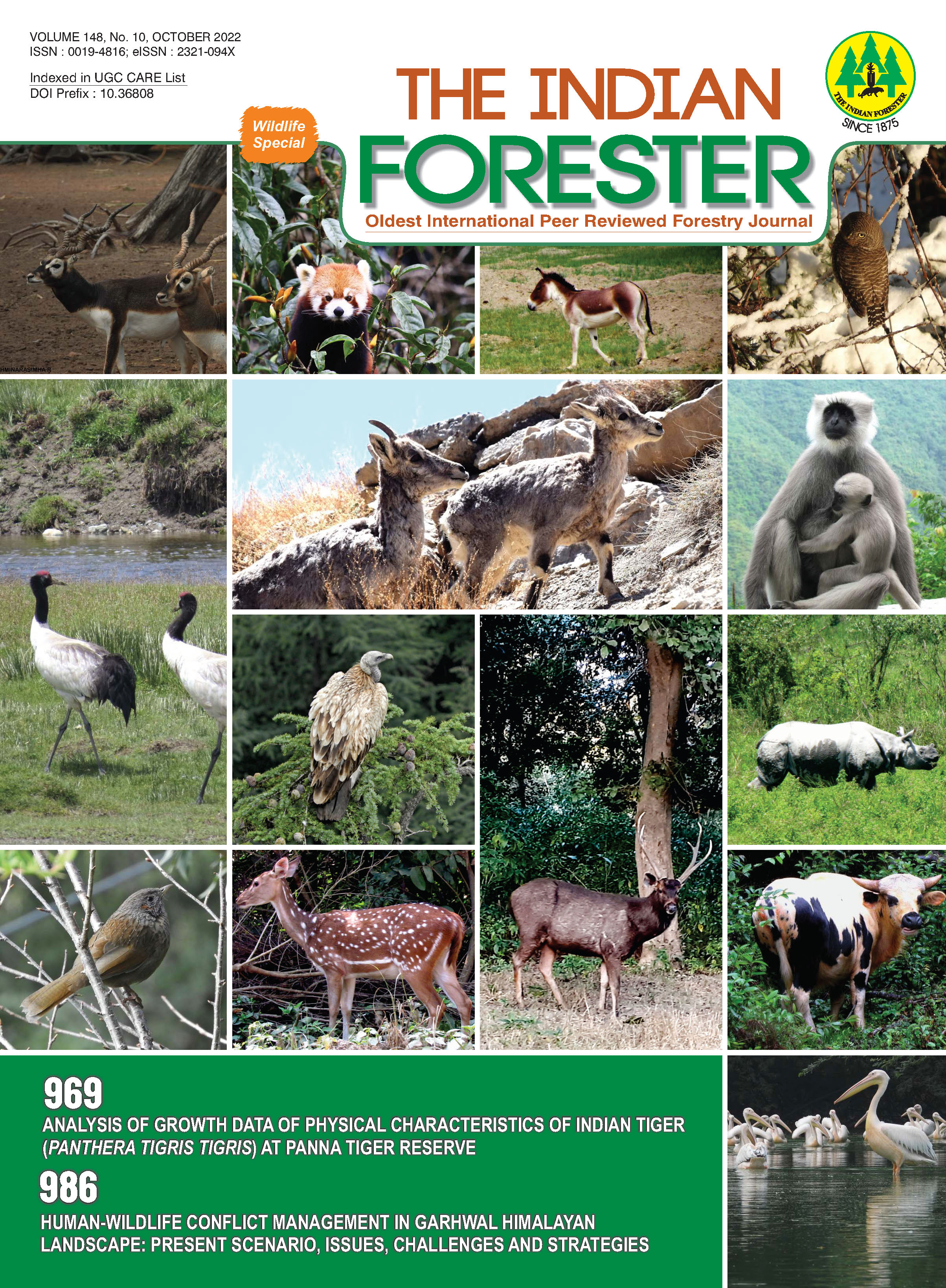Avian Community Structure of Jhilmil Jheel Conservation Reserve, Haridwar, Uttarakhand
DOI:
https://doi.org/10.36808/if/2022/v148i10/163182Keywords:
Bird community, Diversity, Richness, Abundance, IBA, Jhilmil Jheel, GuildAbstract
A survey of avifauna was carried out in Jhilmil Jheel Conservation Reserve (JJCR) of Haridwar Forest Division, Uttarakhand during 2018-2020. Point count method was used to count birds in six habitats viz., plantation, mixed forest, riverine habitat, scrub forest, grasslands and agriculture field. In total, 170 species of birds representing 16 orders and 64 families were recorded. The dominant order was Passeriformes, while the dominant foraging guild was insectivore birds. Most of the bird species were resident. The overall bird species diversity was 4.126. JJCR harbours 10 species of globally threatened avifauna including 3 Critically Endangered, 3 Endangered, and 4 Vulnerable species; in addition, the reserve also has 8 species of Near Threatened birds. The present documentation of avian community structure would help in developing conservation plan of this IBA.References
Ahmed T., Bargali H.S., Bisht D., Mehra G.S. and Khan A. (2019). Status of water birds in Haripura-Baur Reservoir, western Terai-Arc landscape, Uttarakhand, India. Journal of Threatened Taxa, 11(9): 14158–14165.
Ali S. (2002). The Book of Indian Birds. 13th Edition. Oxford University Press, New Delhi, 326pp.
Balodi K.N., Anwar M. and Budhani L. (2018). Diversity and Conservation status of Avifauna in Ramnagar Forest division, Corbett Landscape, Uttarakhand, India. Bird-o-soar #12. In: Zoo's Print, 33(2): 35:45.
Bibby C.J., Burgess N.D., Hill D.A. and Mustoe S. (2000). Bird census techniques. Elsevier, 85-104.
Chettri N., Deb D.C., Sharma E., and Jackson R. (2005). The relationship between bird communities and habitat. Mountain Research and Development, 25(3), 235-243.
Das S.K., Dashahare A., Marathe S., Kundu N. and Kesharwani R. (2011). Status of raptors with special reference to vultures in and around Rajaji National Park, India. World Journal of Zoology, 6(4), 350-356.
De Graaf R.M., Tilghman N.G., and Anderson S.H. (1985). Foraging guilds of North American birds. Environmental Management, 9(6), 493-536.
Grimmett R., Inskipp C. and Inskipp T. (1998). Birds of the Indian Subcontinent. Oxford University Press, Delhi, 889pp.
Joshi K. and Bhatt D. (2011). Birds of three different forest habitats in Nainital district (Western Himalaya), Uttarakhand, India. Indian Birds, 7(2), 33-37.
Joshi R. and Dixit A. (2012). Wildlife mortality on national highway 72 and 74 across the rajaji national park and the haridwar conservation area, north india. International Journal of Conservation Science, 3(2).
Kaushik M., Mohan D. and Singh P. (2012). Response of migrant and resident bird communities to anthropogenic disturbances in Shiwalik landscape, Uttarakhand, India. J. Bombay Nat. Hist. Soc, 109, 111-122.
Menon T., Sridhar H. and Shahabuddin G. (2019). Effects of extractive use on forest birds in Western Himalayas: Role of local and landscape factors. Forest Ecology and Management, 448, 457-465.
Mohan D. (1997). Birds of New Forest, Dehra Dun, India. Forktail, 21-30.
Mohan D., Singh A.P., Sondhi S., Kumar R., Singh P. and Datta S.B. (2016). A Checklist of the Birds of Asan Conservation Reserve. Uttarakhand Forest Department, 1-21.
Pandey S., Joshua J., Rai N.D., Mohan D., Rawat G.S., Sankar K. and Johnsingh A.J.T. (1994). Birds of Rajaji National Park, India. Forktail, 10, 105-114.
Rahmani A.R., Islam M.Z. and Kasambe R.M. (2016) Important Bird and Biodiversity Areas in India: Priority Sites for Conservation (Revised and updated). Bombay Natural History Society, Indian Bird Conservation Network, Royal Society for the Protection of Birds and BirdLife International (U.K.). Pp. 1992 + xii, 1826-1828.
Shahabuddin G., Kumar R. and Verma A. (2006). Annotated checklist of the birds of Sariska Tiger Reserve, Rajasthan, India. Indian birds, 2(3), 71-76. Singh A.P. (2000). Birds of lower Garhwal Himalayas: Dehra Dun valley and neighbouring hills. Forktail, 101-124.
Sinha S.P., Sinha B. and Qureshi Q. (2011). Management and Conservation of Jhilmil Jheel Conservation Reserve. LAP Lambert Academic Publishing, 15-18.
Sultana A. and Khan J.A. (2000). Birds of oak forests in the Kumaon Himalaya, Uttar Pradesh, India. Forktail, 131-146.
Khan T.A. and Chandan (2015). A pilot survey of the avifauna of Rangdum Valley, Kargil, Ladakh (Indian Trans-Himalaya). Journal of Threatened Taxa, 7(6): 7274–7281.
Tiwari R. (2009).“A Study on the Habitat Use and Food Habits of Swamp Deer (Cervus duvauceli duvauceli) In Jhilmil Jheel Conversation Reserve, Haridwar Forest Division, Uttarakhand”, thesis PhD, Saurashtra University,142-143.
Downloads
Downloads
Published
How to Cite
Issue
Section
License
Unless otherwise stated, copyright or similar rights in all materials presented on the site, including graphical images, are owned by Indian Forester.





